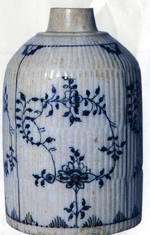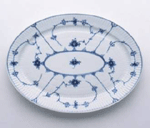|
Blue Decorated Danish Porcelain Has A Long History
By Anne Gilbert
Since it was introduced in 1775 as the Royal Porcelain Manufactory, Danish
porcelain with its blue-on-white decorations has never lost its appeal. The blue
fluted pattern has never stopped being made using floral variations. Glazes on
the early pieces had a slight bluish-green tinge. The name was changed to the
Royal Danish Porcelain Manufactury in 1779, and became known as Royal
Copenhagen.
Kaolin, an important ingredient to the glaze, was imported
beginning in 1778 from France. The result was a pure white glaze that identifies
today's pieces. However, for a short time in 1807 the English blockade of France
made it impossible for the Danish factory to acquire the Kaolin. Pieces made
during this time were gray and mottled.
Pieces made in the 18th century
followed the rococo forms originated in the Meissen factory. Large dinner
services were made that included pieces not in use these days or during the 19th
century. Since this was before refrigeration was in use, foods were kept cool in
three-piece dishes. Ice was placed in the top and bottom bowls with perishable
food in the middle. Another novel piece was the oblong dish with pierced drainer
inserts for fish.
Just as the English made tea a ceremony with many pieces in
the tea service, so did the Danes, adding coffee and chocolate. The chocolate
pots were cylindrical, and the porcelain cover was topped by a tiny brass lid.
When pushed aside, a small hole enabled a stirring stick to be inserted.
In
1853, the Bing & Grondahl porcelain works opened. When they introduced their
under glaze blue decorations in 1886, for the first time Royal Copenhagen had
competition. Bing & Grondahl introduced their annual Christmas plates
beginning in 1895. Royal Copenhagen introduced their Christmas plates in 1908.
In 1987, Bing and Grondahl became part of Royal Copenhagen.
CLUES: Pieces
of Royal Copenhagen identified as being 18th to early 19th century can sell for
thousands of dollars. This includes figures, flower pots, and the more unusual
serving pieces. More affordable and available are pieces from the 1920s. Since
between 1775 and 1820 thirty different marks were registered, it would take an
expert to identify the date and the artist. From the 1830s, numbers were used.
By 1931, a combination of letters were used. Most pieces are marked on the
bottom with the factory mark of three wavy lines. These symbolize the three
waterways of Denmark.
From 1894 to 1900, a crown over the word Denmark was
used. Before 1923, a crown in a circle of the words Royal Copenhagen over wavy
lines and the painter's number were used. These are just a few clues to dating
pieces.
For more information on marks, a very informative internet site is
www.jamiri.dk/Royal-Copenhagen-mark.htm.

|

Tea caddy, pre-1780, made before glaze was perfected. (Photo: Royal Porcelain
Manufactory Collection.)

Blue fluted fish plate, Royal Copenhagen, 20th century. (Photo: courtesy,
private collector.) |